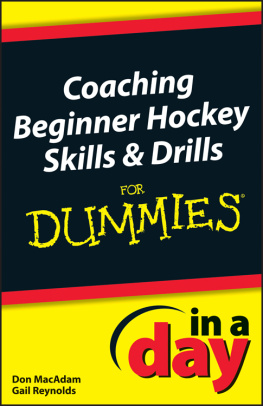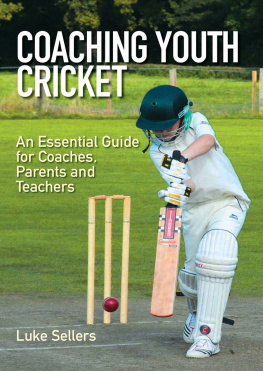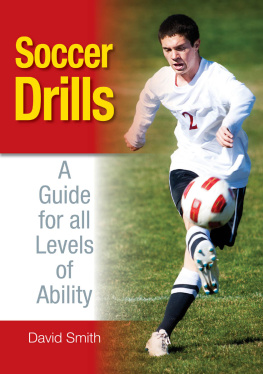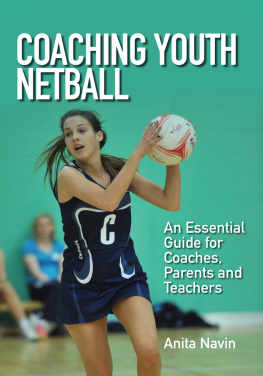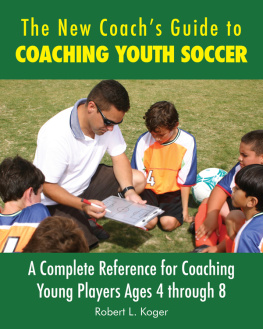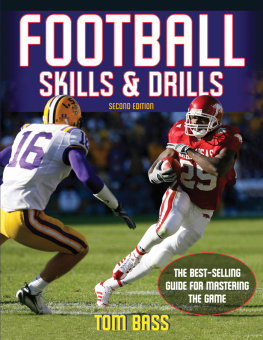Acknowledgments
A special thanks to my wife Michele for her continuing help on every project; to Bruce Curtis for his excellent photographs; to Rita Rosenkranz my agent on this project; to everyone at McGraw-Hill, especially Ben McCanna, for their encouragement, assistance and dedication to the project; and to Harry Johnston my coaching colleague and friend for reminding me what I was like during my first few years of coaching.
CHAPTER 1
Becoming a Coach

When you make the decision to become a youth football coach, you take on an enormous responsibility. You are committing yourself to teach young players how to approach the game in a proper manner, provide them with a safe environment in which to play, and impart the life values that come from playing the game.
As a youth coach, you have the opportunity to introduce young players to one of Americas greatest games, as well as to enjoy the tremendous personal satisfaction that comes from being a coach.
You will have the chance to see your players grow from a disjointed group of awkward young athletes into a smoothly running team. Initial chaos will be replaced with plays that run like clockworkand oh, how wonderful the feeling when it starts to click.
First and foremost, you need to be a great teacher. All great coaches are great teachers. As a coach and teacher it will be your responsibility to:
1. Provide a safe and enjoyable setting for learning to take place.
The practical steps for achieving this goal are as follows:
Inspect the field before the first player arrives for practice.
Greet each player by name.
Take a quick check of each players equipment.
Preplan the practice so the drills are safe and emphasize proper and safe body movements and positions.
Be aware of anyone who may be loitering around the field.
Have at least one coach remain at the field until the last player has been picked up.
Have a prearranged plan to respond to any medical problem that might occur, including a method of contacting parents.
2. Know what is to be accomplished each day.
You and your coaching staff will want to meet prior to each practice, each meeting, and each game to outline and communicate the goals for that day.
As a coach you need to understand not only what you are going to teach but also how and why it fits into the total team picture. Spend your precious practice time teaching only the particular skills needed for your teams offense, defense, or special teams. Should you and your staff determine that the offense will run the ball 70% of the time, try to allocate 70% of your offensive practice time to teaching how to run the ball. On the other hand, if you plan to be a passing team, devote more practice time to perfecting the skills of throwing the ball and running pass routes and less to practicing the skills needed for the option play.
In preparing for a practice, be sure to clarify when you will be teaching an individual technique versus working with the team, and when you will be teaching a skill versus an assignment. For example, when you teach pass protection to the offensive linemen, your concern is how to do the skill. So you need to focus on footwork, balance, and proper positioning of the upper body, lower body, and hands. On the other hand, when you bring the team together to run plays, your focus shifts from teaching how to block to teaching who to block.
3. Make sure everyone participates and has fun.
Players at all levels, and especially at the youth level, want (and deserve) to participate and have fun in practices and in games. Young players, in particular, want to stay active. Because attention spans may be limited, keep your drills brisk, short, and varied. It is better to use a number of drills to teach one skill than one drill to teach multiple skills.
Example: When you are teaching wide receivers to run a certain pass route, do not use the ball in the drill. Break down the pass route into various drills that can be done quickly by all your receivers. This sequence should include: a stance drill; a start drill in which they drive off the line; a drill in which the focus is on making the break at the correct depth; and, finally, a drill to come out of the break and complete the route.
Design your practices so that you keep all the players active and participating. Multiple repetitions of a short, brisk drill are better than one that goes on forever. Once you have explained the drill, try to keep lectures to a minimum. Above all, keep it fun and upbeat.
4. Present the information in a manner players can understand.
Each coach brings terms and ideas based on his experience and background. Football terms and experiences that are familiar to you may be a foreign language to your players. Make every effort to convey information in a manner they can easily understand. The object is to teach kids, not to impress parents or your peers with your knowledge. When the kids improve and have fun, thats impressive. So:
Avoid using a one- or two-word term as a shorthand for a skill or technique the first time you teach it. Instead, describe it fully.
Once you describe it, tell them the name of the skill or technique and use this name each time you refer to it after that.
Give your players a full description of what you want them to do.
Have them practice the skill or technique.
Be prepared that players may need two or three practices to learn football terms; one introduction may not be enough.
Do the same with drills: teach the drill, give it a name, then refer to the drill only by that name so players equate the drill to the skill being taught.
Example: You may already know in your mind what a reach block is and how a player should make this block, but do not assume that your young players have the same knowledge.
5. Be positive when communicating with players, parents, and officials.
As a coach you need to think through what you want your players to do and instruct them in a step-by-step manner, making certain they truly understand what you are asking from them and how it fits into the total football experience. Telling them what to do usually takes more thought and may take more time, but your rewards in team performance and the players improvement will be far greater than when you simply tell them what not to do.
Give the same consideration when speaking to a players parents. Stay positive in your conversation regardless of what the parent is saying to you. Try to answer their questions concerning their son, but avoid being drawn into a discussion of any other player on the team.
Your players will not only learn from what you teach, they will constantly learn by observing your behavior around the team and during a game.
Treat the least skilled player on the squad exactly as you treat a star player.
Stay calm.
Speak respectfully to the team, parents, and officials.
Show respect in communicating with other staff members.
Make individual corrections during the game when the player is off the field.
Be respectful to the opposing coaching staff and team.
One of the greatest lessons your players will learn from you, as a coach, is how you communicate with officials during a game. Show officials the respect they deserve, and save any discussions or questions for a time-out or halftime.



